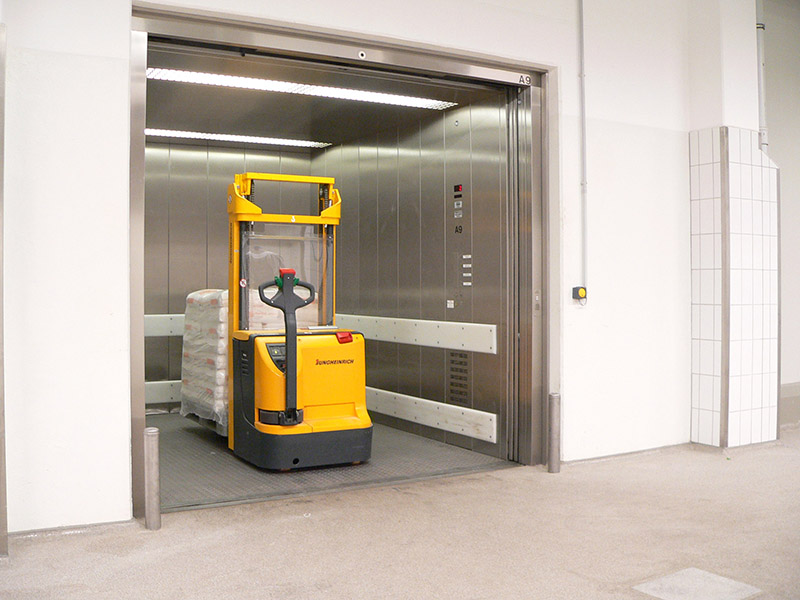The bad news to start with: for years, the prices for modernisations or the new construction of a lift have been rising markedly, according to specialist planner Hendrik Hesse, proprietor of Aufzugsberatung Hesse (Lift Consultancy Hesse) in Karlsruhe. There is no prospect of the situation on the lift market improving in the next few years either.
Passenger lift from 30,000 euros
When it comes to specific numbers, the first thing that has to be clarified is whether it is to be a passenger lift for inside or outside, a stair lift, disabled lift, cargo or construction lift? These factors play a decisive role in determining the price of a lift. Moreover, the costs depend on the number of stops and loading as well as quality, design and the corresponding demand.
In the field of new construction, one currently has to reckon with prices from approximately 30,000 euros for the first two stops for a normal passenger lift. After this, one should budget about 3,000 to 5,000 euros per stop, according to specialist planner Hesse. However, cargo lifts can be far more expensive due to the high loading option. In this case, the shaft is provided by the client.
10,000 to 15,000 euros per stop
In the event of retrospective installation (retrofitting) of a lift in an existing building, the location is the decisive component. Depending on the building structure, the lift can also be attached outside.
Based on the experience of the expert, building owners should budget for approximately 10,000 to 15,000 euros per stop (for example, made of concrete, steel, glass shaft design) – on top of this comes the price for the lift. Particularly in the case of external glass lifts, attention should be paid in advance to the future location in terms of insolation. No one wants to be grilled at 40° C in a stuck lift …
On top of this come the costs for ceiling and wall penetrations or also a structural engineer. Consequently, one can quickly get up to 120,000 euros or more for the retrofitting costs of a lift, depending on the number of stops.
Sliding or swing doors?
Passenger lifts for a single-family home are somewhat more affordable: a home lift under the Machinery Directive with low requirements can also cost less than 30,000 euros, explains the specialist planner. But the prices also depend on the supplier and demand. On top of this come the costs for a shaft – if not already present – (e.g. in dry construction, glass design, etc.).
During planning, one should consider in advance whether one would like to install sliding doors or swing doors. Hesse advises buyers to consider carefully whether there is enough room in the stairwell. These details often only become important in ten to twenty years when one is really dependent on the home lift.”
Lift group or small lift company?
Lifts from company groups are generally somewhat more affordable than lifts from smaller providers, since they produce in lower unit numbers. But in his view, smaller suppliers also have advantages compared to bigger companies. For example, smaller companies are often set up to be more flexible and can provide more assistance for customised solutions.
The boss is often the contact there in the event of problems, explains Hesse. “One will not be far off the mark for a normal standard lift for offices or a flat owners’ association with the simple rule of thumb mentioned above. If necessary, an independent specialist planner can assist you.”
Get at least three offers
But in general, one can say: whatever lift is involved, clients should always get at least three offers and compare them at their leisure – the consumer protection agencies also advise this.
Incidentally, in the meantime the first companies are beginning to demand money for submitting an offer, in the experience of Hesse. His tip: right at the start, customers should not just ask about the costs for the lift, but also the maintenance costs. He recommends maintenance companies certified under DIN EN 13015, “But this is not obligatory.”
Cost comparisons from the Internet? Watch out!
There are various providers on the Internet that offer cost comparisons. However, you should be aware that these are often fronts for particular lift manufacturers – therefore, their recommendations are to be treated with a certain amount of caution. “Several of these portals often just seem to want to harvest customer addresses for the sales departments of lift companies,” warns the expert.
Of course, it is also questionable just how meaningful such calculations are – since they naturally cannot take the circumstances on the spot into account. “If portals could do this, one probably wouldn’t need any specialist planners and consultants for the lift sector anymore,” said Hesse.
Exploit the expertise of the sector
Even if it costs more at first sight: specialist planner Hendrik Hesse recommends exploiting the expertise of his sector, “Naturally, this advice isn’t free. But it can help customers to save money in the long term, because the lift jungle is difficult to keep track of even for experts, with its numerous regulations, laws, maintenance companies and offers. In the interests of our clients, our sector maintains an independent, neutral perspective and can ensure clarity, cost transparency and safety when choosing the partner for new construction, modernisation, repair or maintenance of lifts.”
Anyone looking for such an expert, can simply enter the key words “specialist planner, consultant, lift” in Google and click through the first few pages - by then, he should have found a consultant in his neighbourhood.
Rising prices One reason for the rising prices on the lift market, according to specialist planner Hesse, apart from the rising procurement costs of material, the generally advanced age of lifts and the associated increasing need for repairs is the hazard assessment (or also safety analysis), which lift operators have increasingly been called on to undergo since 2015 by the authorised inspection bodies (TÜV,DEKRA, GTÜ, etc.). The aim of the hazard analysis is to uncover and correct potential lift risks.
This hazard analysis is unnecessary for lifts exclusively used by the operators, explained Frank Kurtenbach, Business Line Manager Modernisation of Schindler. “But here too the delimitation is difficult: as soon as third parties use the lift, for example visitors in a multi-family house of a residential owners’ association, an operating safety obligation would have to be met.”
Maintenance The content of the maintenance is what counts, not the name, emphasises the consultant Hesse. Here, some companies offer the same under different names. “Sometimes it’s called maintenance, basic maintenance, system maintenance inspection, care or, or, or ...” His tip is to read through the precise service content. Even the title full maintenance can involve exclusions, according to specialist planners, “Some providers exclude drive motors or also car and landing doors from performance.”
Many agreements can be boosted with troubleshooting and test fee assumption. In individual cases, customers should specify in advance what exactly they need. The expert’s tip, “Pay attention when reaching an agreement (or retrospective agreement) of an emergency call agreement and a maintenance agreement to the same contractual term. Five-year contractual terms are only just appropriate. A ten-year term in the case of a residential owners' association should be seen rather critically.”
Many buyers dispense with maintenance, particularly in the case of home lifts. Hesse advises against this, “I recommend having maintenance or visual maintenance once a year to identify possible errors in advance.” Incidentally, particularly in the case of home lifts, there are suppliers who also offer a ten-year guarantee if the customer has the home lift maintained regularly.






















Write a comment